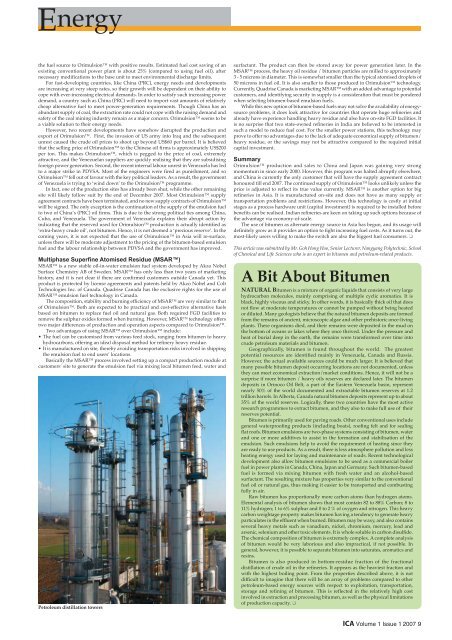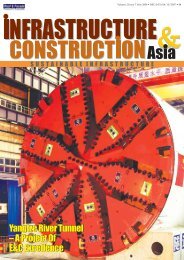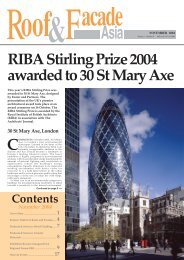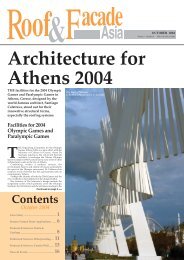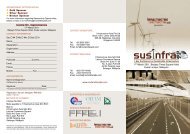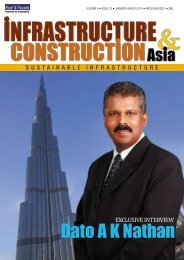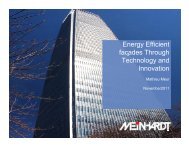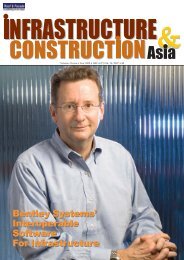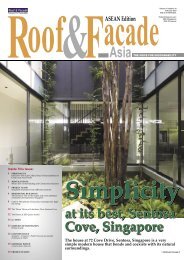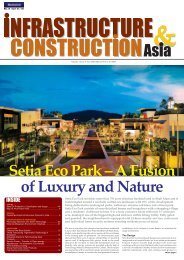ICA_Feb 07.pdf - Roof & Facade
ICA_Feb 07.pdf - Roof & Facade
ICA_Feb 07.pdf - Roof & Facade
You also want an ePaper? Increase the reach of your titles
YUMPU automatically turns print PDFs into web optimized ePapers that Google loves.
Energy<br />
the fuel source to Orimulsion with positive results. Estimated fuel cost saving of an<br />
existing conventional power plant is about 25% (compared to using fuel oil), after<br />
necessary modifications to the base unit to meet environmental discharge limits.<br />
For fast-developing countries, like China (PRC), energy needs and developments<br />
are increasing at very steep rates, so their growth will be dependent on their ability to<br />
cope with ever-increasing electrical demands. In order to satisfy such increasing power<br />
demand, a country such as China (PRC) will need to import vast amounts of relatively<br />
cheap alternative fuel to meet power-generation requirements. Though China has an<br />
abundant supply of coal, the extraction rate could not cope with the raising demand and<br />
safety of the coal mining industry remain as a major concern. Orimulsion seems to be<br />
a viable solution to their energy needs.<br />
However, two recent developments have somehow disrupted the production and<br />
export of Orimulsion. First, the invasion of US army into Iraq and the subsequent<br />
unrest caused the crude oil prices to shoot up beyond US$60 per barrel. It is believed<br />
that the selling price of Orimulsion to the Chinese oil firms is approximately US$200<br />
per ton. This makes Orimulsion, which is pegged to the price of coal, extremely<br />
attractive, and the Venezuelan suppliers are quickly realising that they are subsidising<br />
foreign power generation. Second, the recent internal labour unrest in Venezuela has led<br />
to a major strike in PDVSA. Most of the engineers were fired as punishment, and so<br />
Orimulsion fell out of favour with the key political leaders. As a result, the government<br />
of Venezuela is trying to ‘wind down’ to the Orimulsion programme.<br />
In fact, one of the production sites has already been shut, while the other remaining<br />
site will likely follow suit by the end of December 2007. Most Orimulsion supply<br />
agreement contracts have been terminated, and no new supply contracts of Orimulsion<br />
will be signed. The only exception is the continuation of the supply of the emulsion fuel<br />
to two of China’s (PRC) oil firms. This is due to the strong political ties among China,<br />
Cuba, and Venezuela. The government of Venezuela explains their abrupt action by<br />
indicating that the reserved used for Orimulsion production is actually identified as<br />
‘extra-heavy crude oil’, not bitumen. Hence, it is not deemed a ‘precious reserve’. In the<br />
coming years, it is not expected that the use of Orimulsion in Asia will re-surface,<br />
unless there will be moderate adjustment to the pricing of the bitumen-based emulsion<br />
fuel and the labour relationship between PDVSA and the government has improved.<br />
Multiphase Superfine Atomised Residue (MSAR)<br />
MSAR is a new stable oil-in-water emulsion fuel system developed by Akzo Nobel<br />
Surface Chemistry AB of Sweden. MSAR has only less than two years of marketing<br />
history, and it is not clear if there are confirmed customers outside Canada yet. This<br />
product is protected by license agreements and patents held by Akzo Nobel and Colt<br />
Technologies Inc. of Canada. Quadrise Canada has the exclusive rights for the use of<br />
MSAR emulsion fuel technology in Canada.<br />
The composition, stability and burning efficiency of MSAR are very similar to that<br />
of Orimulsion. Both are expected to be practical and cost-effective alternative fuels<br />
based on bitumen to replace fuel oil and natural gas. Both required FGD facilities to<br />
remove the sulphur oxides formed when burning. However, MSAR technology offers<br />
two major differences of production and operation aspects compared to Orimulsion.<br />
Two advantages of using MSAR over Orimulsion include:<br />
• The fuel can be customised from various feed stock, ranging from bitumen to heavy<br />
hydrocarbons, offering an ideal disposal method for refinery heavy residue.<br />
• It is manufactured on site, thereby avoiding transportation risks involved in shipping<br />
the emulsion fuel to end users’ locations.<br />
Basically the MSAR process involved setting up a compact production module at<br />
customers’ site to generate the emulsion fuel via mixing local bitumen feed, water and<br />
Petroleum distillation towers<br />
surfactant. The product can then be stored away for power generation later. In the<br />
MSAR process, the heavy oil residue / bitumen particles are milled to approximately<br />
3 - 5 microns in diameter. This is somewhat smaller than the typical atomised droplets of<br />
50 microns in fuel oil. It is also smaller to those produced in Orimulsion technology.<br />
Currently, Quadrise Canada is marketing MSAR with an added advantage to potential<br />
customers, and identifying security in supply is a consideration that must be pondered<br />
when selecting bitumen-based emulsion fuels.<br />
While this new option of bitumen-based fuels may not solve the availability of energysource<br />
problems, it does look attractive for countries that operate huge refineries and<br />
already have experience handling heavy residue and also have on-site FGD facilities. It<br />
is no surprise that two state-owned refineries in India are believed to be interested in<br />
such a model to reduce fuel cost. For the smaller power stations, this technology may<br />
prove to offer no advantages due to the lack of adequate economical supply of bitumen/<br />
heavy residue, or the savings may not be attractive compared to the required initial<br />
capital investment.<br />
Summary<br />
Orimulsion production and sales to China and Japan was gaining very strong<br />
momentum in since early 2000. However, this program was halted abruptly elsewhere,<br />
and China is currently the only customer that will have the supply agreement contract<br />
honoured till end 2007. The continued supply of Orimulsion looks unlikely unless the<br />
price is adjusted to reflect its true value currently. MSAR is another option for big<br />
refineries in Asia. It is manufactured on-site and does not have as many supply or<br />
transportation problems and restrictions. However, this technology is costly at initial<br />
stages as a process hardware unit (capital investment) is required to be installed before<br />
benefits can be realised. Indian refineries are keen on taking up such options because of<br />
the advantage via economy-of-scale.<br />
The use of bitumen as alternate energy source in Asia has begun, and its usage will<br />
definitely grow as it provides an option to fight increasing fuel costs. As it turns out, the<br />
most-likely users willing to make the switch are also the biggest fuel consumers. ❏<br />
This article was submitted by Mr. Goh Hong Hoo, Senior Lecturer, Nangyang Polytechnic, School<br />
of Chemical and Life Sciences who is an expert in bitumen and petroleum-related products.<br />
A Bit About Bitumen<br />
NATURAL Bitumen is a mixture of organic liquids that consists of very large<br />
hydrocarbon molecules, mainly comprising of multiple cyclic aromatics. It is<br />
black, highly viscous and sticky. In other words, it is basically thick oil that does<br />
not flow at moderate temperatures or cannot be pumped without being heated<br />
or diluted. Many geologists believe that the natural bitumen deposits are formed<br />
from the remains of ancient, microscopic algae and other prehistoric once-living<br />
plants. These organisms died, and their remains were deposited in the mud on<br />
the bottom of oceans or lakes where they once thrived. Under the pressure and<br />
heat of burial deep in the earth, the remains were transformed over time into<br />
crude petroleum materials and bitumen.<br />
Geographically, bitumen is found throughout the world. The greatest<br />
potential resources are identified mainly in Venezuela, Canada and Russia.<br />
However, the actual available sources could be much larger. It is believed that<br />
many possible bitumen deposit occurring locations are not documented, unless<br />
they can meet economical extraction/market conditions. Hence, it will not be a<br />
surprise if more bitumen / heavy oils reserves are declared later. The bitumen<br />
deposits in Orinoco Oil Belt, a part of the Eastern Venezuela basin, represent<br />
nearly 50% of the world documented and extractable bitumen reserves at 1.2<br />
trillion barrels. In Alberta, Canada natural bitumen deposits represent up to about<br />
35% of the world reserves. Logically, these two countries have the most active<br />
research programmes to extract bitumen, and they also to make full use of their<br />
reserves potential.<br />
Bitumen is primarily used for paving roads. Other conventional uses include<br />
general waterproofing products (including boats), roofing felt and for sealing<br />
flat roofs. Bitumen emulsions are two-phase systems consisting of bitumen, water<br />
and one or more additives to assist in the formation and stabilisation of the<br />
emulsion. Such emulsions help to avoid the requirement of heating since they<br />
are ready to use products. As a result, there is less atmosphere pollution and less<br />
heating energy used for laying and maintenance of roads. Recent technological<br />
development also allow bitumen emulsions to be used as a commercial boiler<br />
fuel in power plants in Canada, China, Japan and Germany. Such bitumen-based<br />
fuel is formed via mixing bitumen with fresh water and an alcohol-based<br />
surfactant. The resulting mixture has properties very similar to the conventional<br />
fuel oil or natural gas, thus making it easier to be transported and combusting<br />
fully in air.<br />
Raw bitumen has proportionally more carbon atoms than hydrogen atoms.<br />
Elemental analysis of bitumen shows that most contain 82 to 88% Carbon; 8 to<br />
11% hydrogen; 1 to 6% sulphur and 0 to 2 % of oxygen and nitrogen. This heavy<br />
carbon weightage property makes bitumen having a tendency to generate heavy<br />
particulates in the effluent when burned. Bitumen may be waxy, and also contains<br />
several heavy metals such as vanadium, nickel, chromium, mercury, lead and<br />
arsenic, selenium and other toxic elements. It is whole soluble in carbon disulfide.<br />
The chemical composition of bitumen is extremely complex. A complete analysis<br />
of bitumen would be very laborious and also impractical, if not possible. In<br />
general, however, it is possible to separate bitumen into saturates, aromatics and<br />
resins.<br />
Bitumen is also produced in bottom-residue fraction of the fractional<br />
distillation of crude oil in the refineries. It appears as the heaviest fraction and<br />
with the highest boiling point. From the properties described above, it is not<br />
difficult to imagine that there will be an array of problems compared to other<br />
petroleum-based energy sources with respect to exploitation, transportation,<br />
storage and refining of bitumen. This is reflected in the relatively high cost<br />
involved in extraction and processing bitumen, as well as the physical limitations<br />
of production capacity. ❏<br />
<strong>ICA</strong> Volume 1 Issue 1 2007 9


